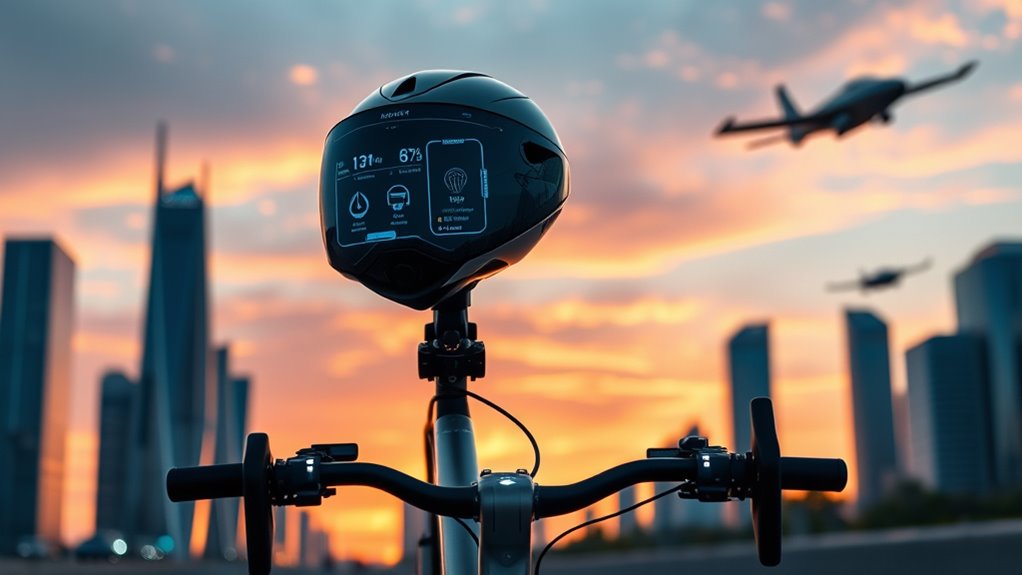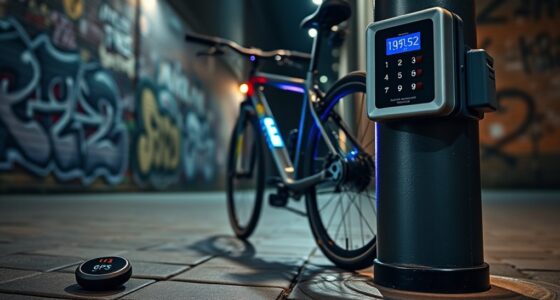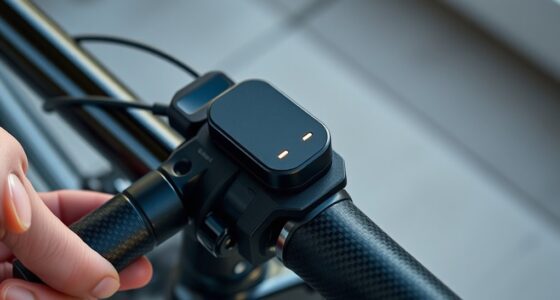Future trends in smart cycling gadgets focus on seamless connectivity with wearables, advanced security features like GPS tracking and biometric locks, and personalized data analytics for improving performance. You’ll see innovations like augmented reality displays, real-time health monitoring, and adaptive systems that respond to your riding style and environment. These gadgets aim to make cycling safer, more efficient, and engaging. Keep exploring to discover how these breakthroughs will change your rides.
Key Takeaways
- Enhanced connectivity and ecosystem integration enable seamless data sharing and security across multiple cycling devices and wearables.
- AI-driven analytics provide personalized training insights, real-time feedback, and performance optimization tailored to individual goals.
- Advanced biometric sensors monitor health metrics continuously, supporting safety and informed training adjustments during rides.
- Smart safety features like crash detection, adaptive lighting, and obstacle sensors improve rider protection and accident prevention.
- Augmented reality displays and adaptive technologies deliver real-time navigation, performance cues, and immersive training experiences.
Enhanced Connectivity and Integration With Wearable Devices
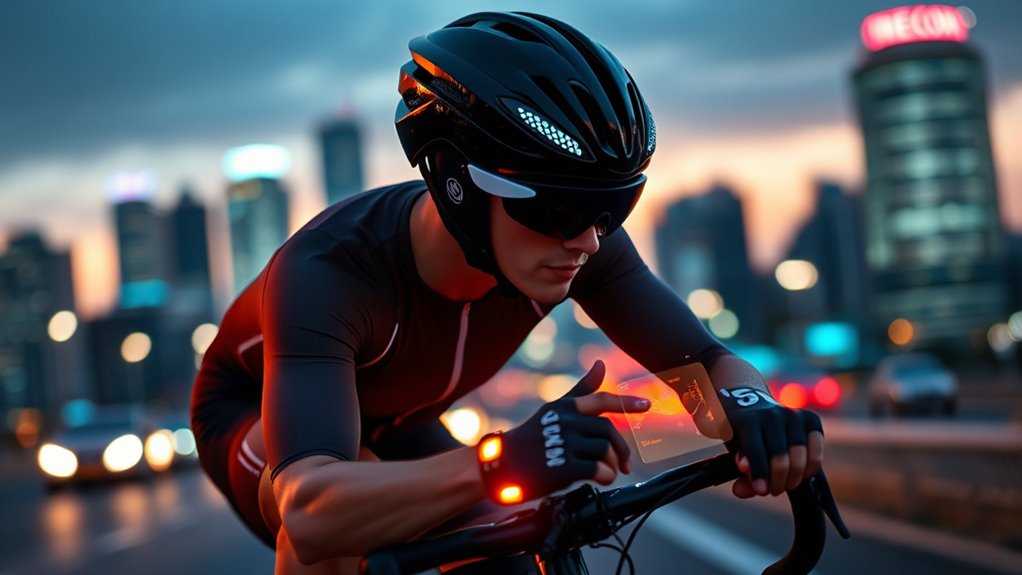
Enhanced connectivity and integration with wearable devices are transforming how cyclists monitor and improve their performance. You can now seamlessly share data between your smart cycling gadgets and wearable devices like smartwatches and fitness bands. Advanced connectivity features, such as Bluetooth 5.0 and ANT+, enable your cycling computers, heart rate monitors, and cadence sensors to communicate effortlessly with multiple wearables at the same time. Emerging smart cycling gadgets can sync with your wearables to deliver real-time updates, route planning, and safety alerts directly to your smartwatch or AR glasses. As 5G technology develops, data transfer becomes faster and more reliable, supporting live tracking and video streaming. Ecosystems are forming where wearable tech, bike computers, and smartphones collaborate via cloud platforms, offering holistic analytics, maintenance alerts, and social sharing options. The integration of wireless communication protocols ensures uninterrupted data flow and enhances user experience. Additionally, interoperability standards are being adopted to facilitate smoother device integration across different brands and platforms. Privacy considerations are crucial as these devices exchange sensitive health and location data, emphasizing the importance of secure data management. Furthermore, the development of smart home integration allows cyclists to connect their devices with home automation systems, creating a more comprehensive and connected environment. As the Internet of Things continues to expand, the potential for interconnected cycling ecosystems will grow even further, providing users with richer, more integrated experiences.
Personalized Data Insights and Performance Metrics
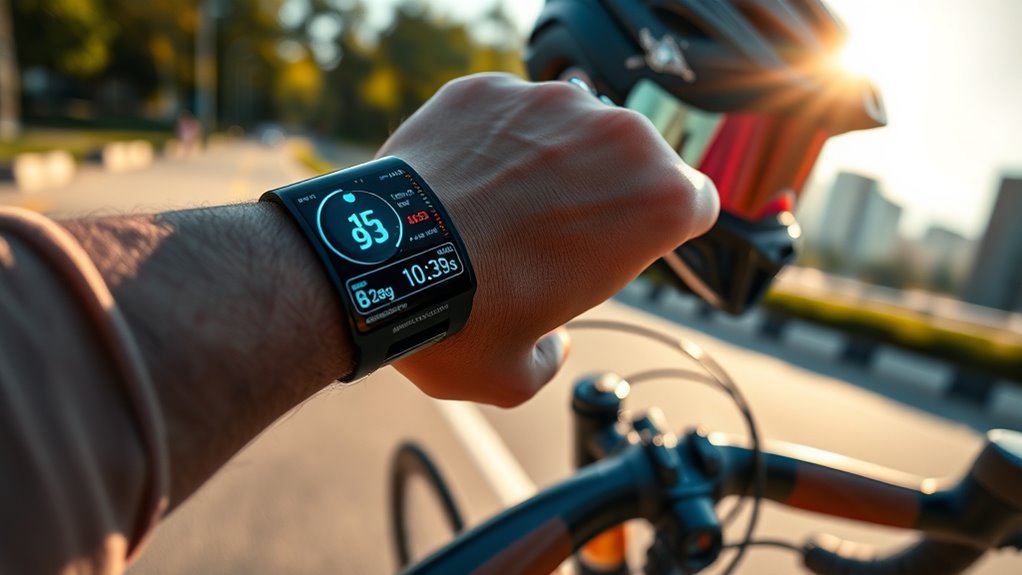
Smart cycling gadgets now use AI to analyze your data, giving you tailored training plans and real-time feedback. You can customize which metrics you see, like power zones or cadence, to focus on what matters most to your goals. As technology advances, your devices will provide deeper insights and more precise performance tracking to help you improve faster. Incorporating skin care benefits can also enhance comfort during long rides. Additionally, advancements in gadget compatibility will allow seamless integration across various devices and platforms, creating a more unified cycling experience. Understanding layer concepts can further optimize how your devices process and display data for better usability. Moreover, leveraging payment security features ensures your data remains protected as these innovations become more interconnected. Keeping abreast of remote hackathons can also inspire new ideas for connected cycling technology that transcends geographical boundaries.
Advanced Analytics Integration
By integrating advanced analytics into cycling gadgets, you gain access to real-time, personalized performance insights that adapt to your unique riding profile. These devices use machine learning algorithms to analyze your historical data, delivering predictive insights like fatigue levels and training zones. You can track metrics such as power output, cadence, and heart rate with enhanced accuracy, helping you understand your performance better. Advanced analytics also power detailed visualizations, including customizable dashboards and trend reports, so you can monitor your progress over time. Additionally, seamless integration with third-party platforms like Strava and TrainingPeaks allows for extensive performance analysis and easy data sharing. Future developments will likely include AI-driven coaching and biomechanical assessments, further optimizing your riding efficiency and reducing injury risk. Performance metrics can be further refined through continuous data collection, enabling smarter training decisions and data-driven insights.
Customizable Metrics Display
Customizable metrics displays let you tailor your cycling gadget’s interface to focus on the data most important to your training goals. With smart cycling gadgets, you can select and prioritize specific performance metrics like power, cadence, heart rate, or GPS, ensuring your device shows what matters most. Advanced devices now allow you to create personalized dashboards, making it easy to monitor your progress. This data customization boosts training efficiency by providing real-time feedback, helping you optimize workouts and track improvements over time. Incorporating wave and wind data can further enhance your understanding of environmental influences on your ride. Manufacturers are also exploring user interface innovations to make customization more intuitive and accessible for riders of all experience levels.
Advanced Safety Features and Accident Prevention Technologies
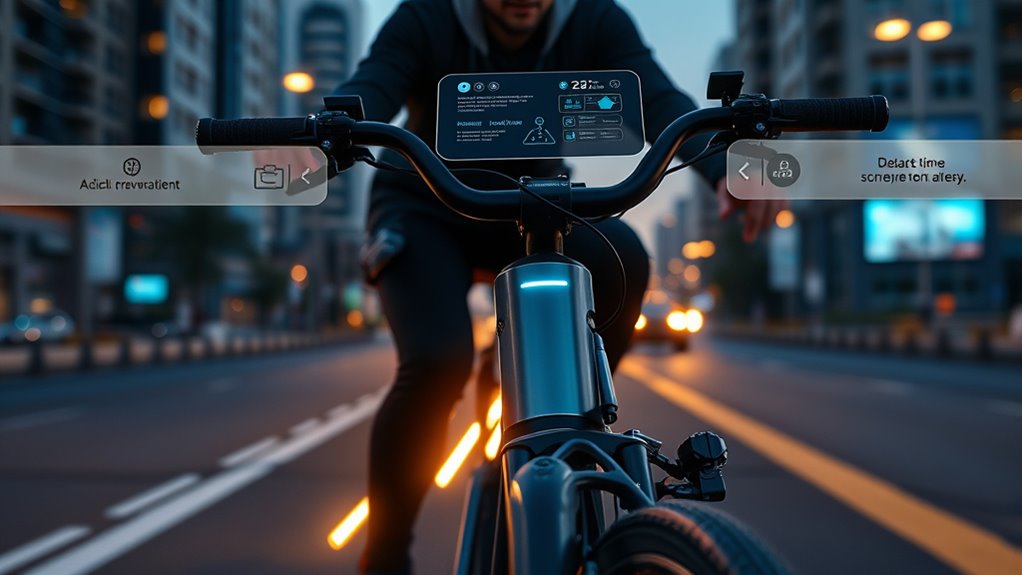
Advanced safety features are transforming how cyclists avoid accidents and respond to emergencies. Connected bike systems now include crash sensors that detect impacts and automatically alert emergency services within seconds, ensuring rapid assistance. Smart helmets equipped with inflatable airbags and crash sensors deploy instantly during collisions, minimizing injuries. Camera and radar integration enhances cyclist detection and sends automatic braking alerts to nearby vehicles, improving visibility and preventing collisions. Wearable devices with AI-powered fall detection analyze your movements, warning you of potential accidents before they happen. Additionally, GPS-based intelligent lighting adapts brightness and signaling based on your environment, boosting visibility. The integration of reactive materials further enhances the responsiveness of safety gear, providing an extra layer of protection. Incorporating wireless connectivity allows for real-time data sharing between devices, increasing overall safety and situational awareness. Moreover, advancements in sensor technology enable more precise detection of hazards, further reducing risks. These innovations collectively create a safer riding experience, reducing the risk of accidents and ensuring quicker responses when emergencies occur. Enhanced safety protocols are also being adopted to standardize safety measures across devices and regions, promoting a consistent level of protection for cyclists worldwide.
Real-Time Health Monitoring and Biometric Feedback
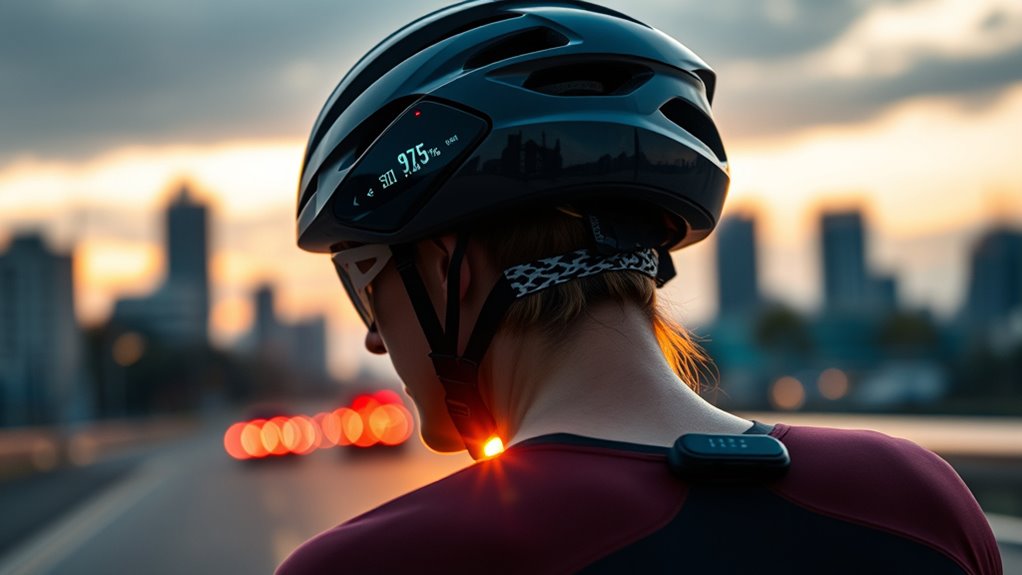
Real-time health monitoring gadgets are revolutionizing cycling by providing immediate insights into your physiological state. Using wearable biosensors, these devices track essential signs like heart rate, oxygen saturation, and respiratory rate during your ride. This biometric feedback helps you adjust effort levels instantly, optimizing performance and safety. Developmental stages are also considered in designing these gadgets to ensure they cater to users of all ages and fitness levels. Imagine having:
- Continuous biometric feedback displayed on your screen
- Alerts for irregular heart rhythms or fatigue
- Seamless data transmission to your smartphone or cycling computer
- Personalized training suggestions based on real-time data
- Non-invasive sensors embedded in your gear for comfort
These advancements enable real-time monitoring that detects anomalies early, reducing health risks. As wearable biosensors become more sophisticated and integrated, your rides will be safer, smarter, and more tailored to your physiological responses.
Augmented Reality Displays for Navigation and Training
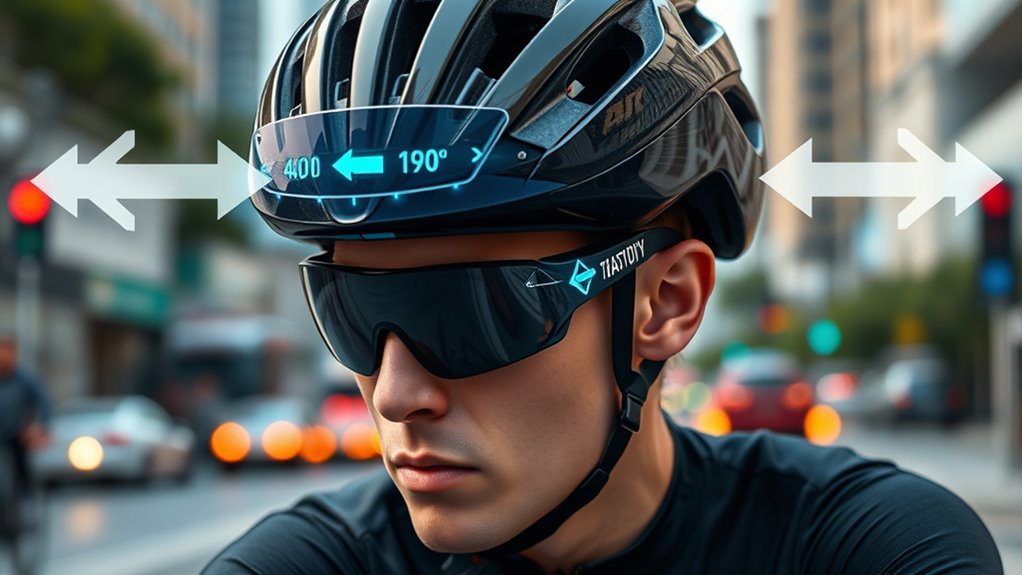
Augmented reality displays are transforming how you navigate and train on your bike by projecting essential information directly into your line of sight. AR head-up displays (HUDs) can show turn-by-turn directions, speed, and heart rate data without requiring you to look away from the road, keeping you focused and safe. Lightweight, helmet-compatible AR modules, like smart glasses or visors, deliver real-time, context-aware training feedback, helping improve your performance. These systems also reduce rider distraction, with research showing a 20% decrease in navigation-related errors. By integrating AR with connected sensors and GPS, your device can dynamically adjust routes, detect obstacles, and offer immersive training experiences tailored to your goals. This evolution in AR technology makes cycling safer, more efficient, and more engaging. Additionally, incorporating home modification principles can help create a safer environment for cyclists, especially those with accessibility needs.
Adaptive Technology Responding to Rider Behavior and Environment
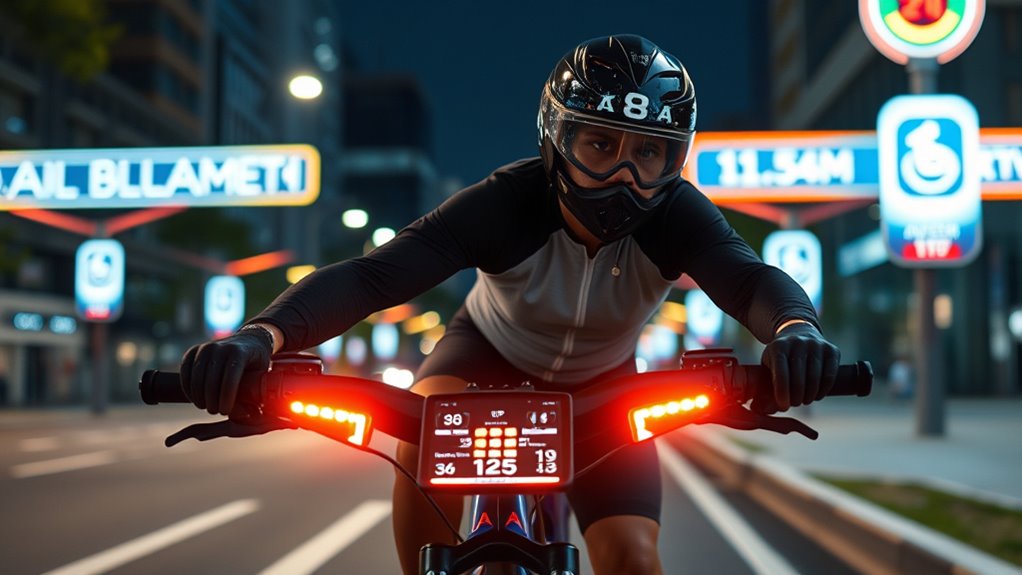
Adaptive cycling gadgets now use sensors and AI to adjust assistance based on your riding style and fatigue levels in real-time. They also respond to environmental factors like weather, terrain, and traffic to optimize your ride and safety. These technologies create a personalized, safer cycling experience that adapts seamlessly as conditions change.
Environment-Adaptive Ride Modes
Have you ever wished your bike could automatically adjust to changing conditions? Environment-adaptive ride modes make that possible. Using sensors and a cycling computer, these systems analyze real-time data like temperature, humidity, and trail conditions, then adjust settings without your input. Imagine riding on a hill, and your bike detects the incline, shifting to more assist or firming suspension for comfort. Or, when weather changes suddenly, it switches modes to optimize performance. These systems can:
- Respond to terrain, obstacles, and inclines
- Switch between eco, standard, and turbo modes
- Adjust suspension firmness dynamically
- Optimize pedal assist based on environmental factors
- Integrate GPS data for route-specific adaptations
This technology elevates your ride, making it safer, smoother, and more efficient across diverse environments.
Behavior-Driven Safety Features
Smart cycling gadgets now incorporate behavior-driven safety features that respond in real-time to your riding habits and environmental conditions. Using sensors and AI, these systems monitor your behavior—like braking strength and cornering—to predict hazards and activate safety protocols proactively. They analyze environmental data from weather and obstacle detection sensors, adjusting visibility aids and alerting you to changing road or trail conditions. Machine learning algorithms refine responses over time, learning from your habits and surroundings for better accuracy. These features aim to reduce accidents by providing context-aware assistance, such as tightening helmet fit or activating lights when risky behaviors or dangerous environments are detected. By adapting to your actions and environment, behavior-driven safety creates a smarter, safer cycling experience.
Smart Accessories for Theft Prevention and Security

As cycling technology advances, security accessories like GPS-enabled locks and bike trackers are transforming theft prevention. These smart gadgets let you monitor your bike’s location in real-time, reducing theft risk. With Bluetooth and cellular connectivity, you can remotely lock or open your bike and get instant alerts if tampering occurs. Some security devices even use biometric authentication, such as fingerprint or facial recognition, to guarantee only you can access your bike. Industry data shows bikes equipped with these gadgets see theft rates drop by up to 70%. Imagine:
Smart bike security with GPS, biometric access, and remote controls drastically reduces theft risks.
- GPS trackers providing real-time location updates
- Tamper alerts notifying you immediately
- Remote locking/unlocking via smartphone
- Biometric access controls
- Theft deterrent features embedded in smart accessories
These innovations bolster your cycling security and protect your investment.
Predictive Navigation and Route Optimization Tools
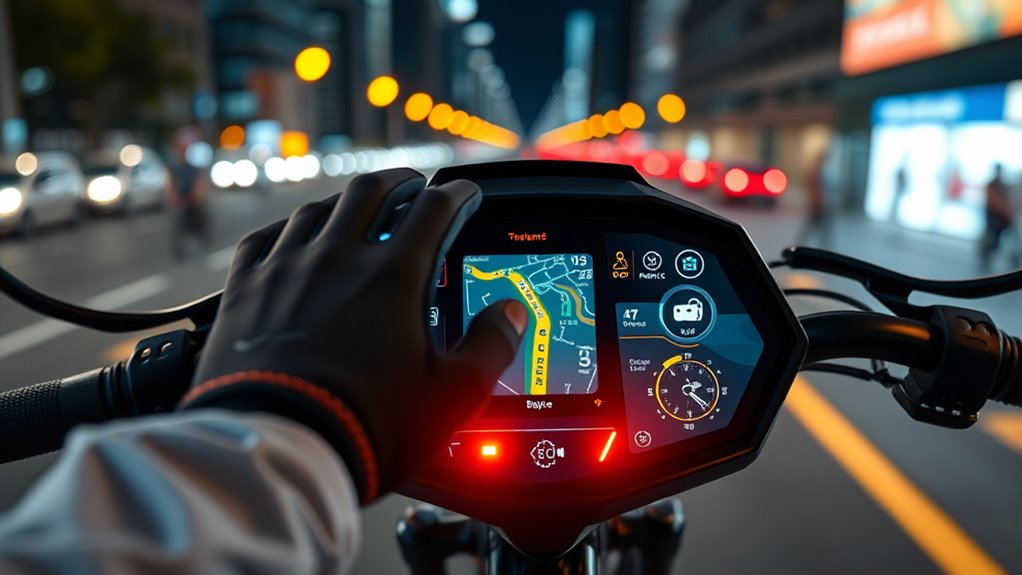
Predictive navigation and route optimization tools are revolutionizing the way cyclists plan and execute their rides. Using AI algorithms, these tools analyze real-time traffic, weather, and rider behavior to suggest the best routes before you start. They can reduce travel time by up to 15% and enhance energy efficiency through dynamic path adjustments. Machine learning personalizes your navigation based on your preferences and upcoming events, making each ride tailored to you. Future gadgets will also feature real-time hazard detection, alerting you to obstacles or closures ahead, and rerouting you instantly. Connectivity with 5G will enable seamless data exchange, facilitating real-time updates and collaborative navigation among riders.
| Feature | Benefit | Technology Used |
|---|---|---|
| Predictive navigation | Optimized routes in advance | AI algorithms |
| Route optimization | Reduced travel time | Dynamic path adjustments |
| Real-time hazard detection | Increased safety | Sensors and AI |
| Personalization | Tailored riding experience | Machine learning |
| Connectivity | Instant updates and sharing | 5G networks |
Frequently Asked Questions
How Will Smart Cycling Gadgets Improve Overall Riding Safety?
Smart cycling gadgets enhance your safety by providing real-time alerts about obstacles, traffic, and weather conditions. They monitor your speed, location, and bike health, helping you make informed decisions. With features like automatic lights, collision warnings, and GPS tracking, you stay visible and aware. These innovations keep you safer on the road, reduce accidents, and boost your confidence, making every ride more secure and enjoyable.
What Are the Privacy Implications of Increased Data Collection?
Did you know that over 80% of cyclists worry about data privacy? As smart cycling gadgets collect more data—like your location and riding habits—you might feel uneasy about who accesses this info. You need to be aware that increased data collection could lead to privacy breaches or tracking without your consent. To protect yourself, regularly review privacy settings and choose devices with transparent data policies.
Can Smart Devices Adapt to Different Cycling Environments Automatically?
You wonder if smart devices can automatically adapt to different cycling environments. Many current devices use sensors and GPS data to adjust their settings in real-time, providing ideal performance and safety. As technology advances, expect these gadgets to become even more responsive, seamlessly changing modes for urban streets, off-road trails, or different weather conditions. This automation helps you ride efficiently and safely without needing manual adjustments.
How Will Integration With Other Smart Home Devices Enhance Cycling Experiences?
You wonder how integration with smart home devices can improve your cycling experience. When your bike connects with smart home systems, you can automatically adjust lighting, climate controls, or music based on your ride. For example, as you start cycling, your smart home can dim the lights or play your favorite playlist. This seamless integration creates a more comfortable, personalized, and efficient environment, making your rides more enjoyable and convenient.
What Future Innovations Might Make Cycling More Accessible for Beginners?
You might wonder how cycling can become easier for beginners. Future innovations could include intuitive, user-friendly interfaces that guide new riders, lightweight and adjustable bikes for comfort, and smart safety features like automatic braking or obstacle detection. Enhanced training programs with virtual coaching could boost confidence. These advancements will make cycling more accessible, enjoyable, and safe, encouraging more people to start riding without feeling overwhelmed or intimidated.
Conclusion
As smart cycling gadgets evolve, you’ll enjoy safer, more personalized rides. Imagine a future where 80% of cyclists use connected devices that prevent accidents and optimize routes in real time. These innovations will transform your cycling experience, making it smarter and safer than ever. Embrace the change, and get ready to ride with confidence, knowing that technology is always working to keep you secure, informed, and ahead of the curve.
